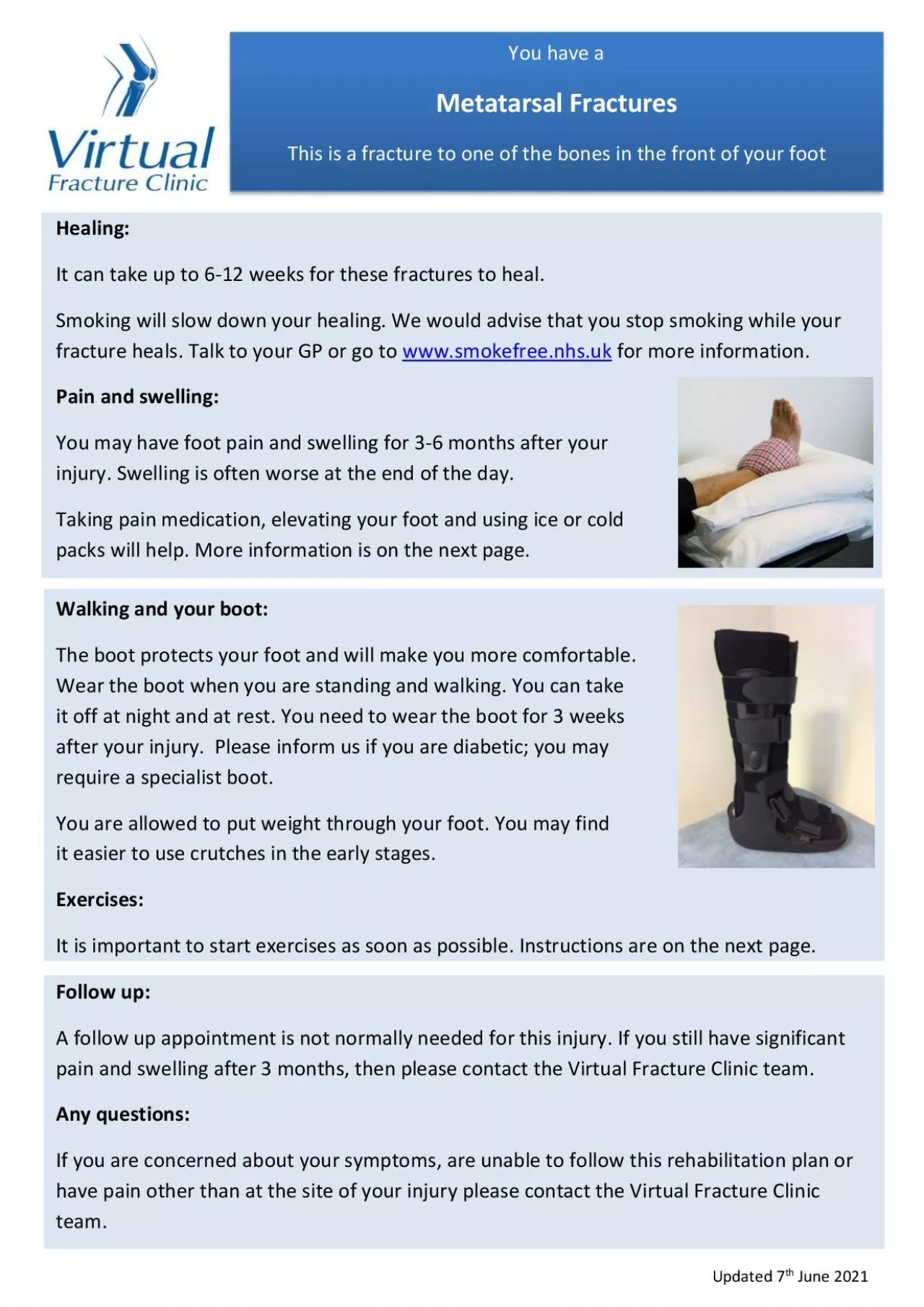

Updated 7 th June 2021 Healing 6 12 weeks for these fractures to heal Smoking will slow down your healing We would advise that you stop smoking while your fracture heals Talk to your GP or g ID: 944547
Download Pdf The PPT/PDF document "It can take up to" is the property of its rightful owner. Permission is granted to download and print the materials on this web site for personal, non-commercial use only, and to display it on your personal computer provided you do not modify the materials and that you retain all copyright notices contained in the materials. By downloading content from our website, you accept the terms of this agreement.
Updated 7 th June 2021 Healing: It can take up to 6 - 12 weeks for these fractures to heal . Smoking will slow down your healing. We would advise that you stop smoking while your fracture heals. Talk to your GP or go to www.smokefree.nhs.uk for more information. Pain and swelling: You may have foot pain and swelling for 3 - 6 months after your injury. Swelling is often worse at the end of the day. Taking pain medication, elevating your foot and using ice or cold packs will help. More information is on the next page. Walking and your boot : The boot protects your foot and will make you more comfortable. Wear the boot when you are standing and walking. You can take it off at night and at rest. You need to wear the boot for 3 weeks after your injury. Please inform us if you are diabetic; you may r equire a specialist boot. You are allowed to put weight through your foot. You may find it easier to use crutches in the early stages. Exercises: It is important to start exercises as soon as possible. Instructions are on the next page. Follow up: A follow up appointment is not normally needed for this injury. If you still have significant pain and swelli
ng after 3 months, then please contact the Virtual Fracture Clinic team. Any questions: If you are concerned about your symptoms , are unable to fol low this rehabilitation plan or have pain other than at the site of your injury please contact the Virtual Fracture Clinic team. You have a Metatarsal Fracture s This is a fracture to one of the bones in the front of your foot Updated 7 th June 2021 Remember to wear your boot whenever standing and walking . You can remove the boot when re sting, at night and to wash and dress . Wear a long sock in your boot. Using a cold pack will help with your pain and swelling. You can use an ice pack or bag of frozen peas wrapped in a damp towel. Put this on your foot for up to 15 minutes every few hours. Make sure the ice is n o t in direct contact with your skin. Try to rest your foot , especially in the first 24 - 72 hours. Raise your foot on a stool or cushions to that it is above the level of your hip. This will help to reduce your swelling. Exercises : Early movement of the ankle and foot is important to promote circulation and reduce the risk of developing a D eep Vein T hrombosis (blood clot). Do these exercis
es 3 - 4 times a day. Start s traight away, you do not need to push into pain . 1. Point your foot up and down. Repeat this 10 time s . 2. With your heels together, move your toes apart to turn the foot outwards. Repeat this 10 times. Do this movement gently within comfort. 3. Make gentle circles with your foot in one direction and then the other direction. Repeat this 10 times. Caring for your injury: Week 1 - 3 Updated 7 th June 2021 It is now 3 weeks since your injury and you can start to wean out of you boot. Stop using it around your own home first and continue wearing it for longer distances. You should aim to be walking without out of your boot by 6 - 8 weeks post injury. It is normal to still have mild discomfort and swelling. This may continue for 3 - 6 months. Activity and Exercise Keep doing your exercises until you have full movement in your foot. Gradually inc rease your level of activity. You should avoid impact activity for 3 months. This includes running, jumping and dancing. Caring for your injury: Week 3 - 12 Updated 7 th June 2021 I am struggling with my boot. What do I do? The boo
t has a thicker sole; this can make you feel uneven. Make sure you wear a supportive shoe or trainer on your uninjured foot. This will reduce stress on other joints. If you are struggling to wean out of your boot please contact us. If you need more advice contact the Virtual Fracture Clinic. I am diabetic, does this change things? If you are diabetic please contact us to discuss your boot. This is particularly important if you have problems with your skin. We may provide you with a specialist diabet ic boot. When can I start driving? You can return to driving when: Y o u are no longer using your boot You can walk comfortably You can perform an emergency stop pain free Always test your ability to drive in a safe environment first. How can I get a certificate for work? You can get a fitness for work statement from your GP What do I do with my boot and crutches when I no longer need them? We are not able to use boots again. These should not be return to the hospital. Crutches can be returned to th e Fracture Clinic or A&E. How do I contact the Virtual Fracture Clinic? Call 01273 696955 extension 63428. Email uhsussex .fracturecare@nhs.net Frequently Asked Questio